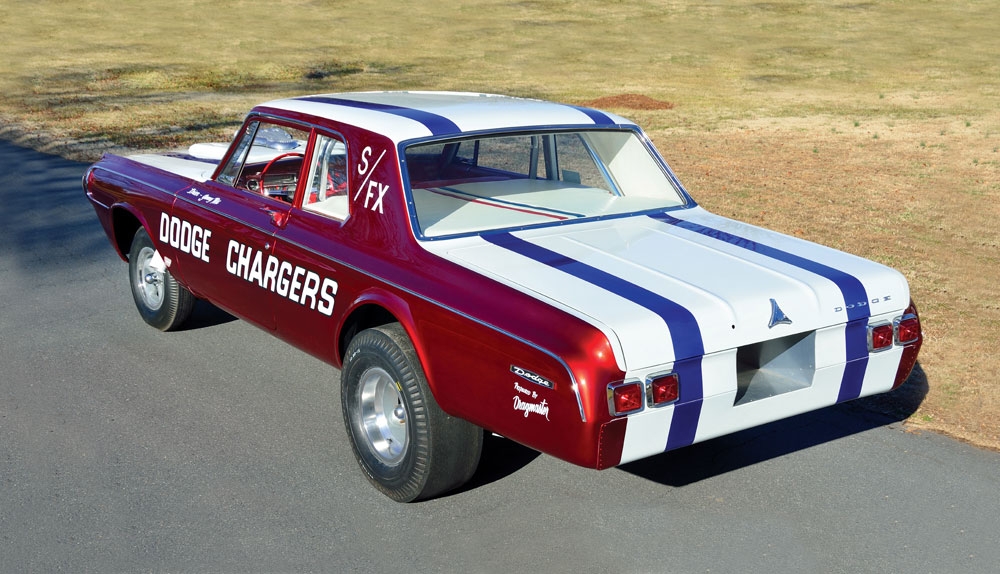SCM Analysis
Detailing
| Vehicle: | 1964 Dodge Charger S/FX |
| Years Produced: | 1964 |
| Number Produced: | 3 |
| Original List Price: | N/A |
| SCM Valuation: | $275k–$325k |
| Tune Up Cost: | $200–$500 (Supercharged) |
| Distributor Caps: | $25 |
| Chassis Number Location: | On plate attached to left front door hinge pillar |
| Engine Number Location: | Engine pad located next to the distributor |
| Club Info: | Mopar Muscle Clubs of America |
| Website: | http://www.nmcadigital.com |
| Alternatives: | 1963 Plymouth Savoy “Jayhawker” A/FX, 1967 Chevrolet Camaro Z/28, 1964 Ford Fairlane 500 Thunderbolt |
| Investment Grade: | A |
This car, Lot 28, sold for $302,500, including buyer’s premium, at Worldwide Auctioneers’ sale in Auburn, IN, on Saturday, September 3, 2011.
There are three submarkets for vintage race cars: those that resemble the actual car that was campaigned, a backup car that never saw track time, and those that truly are the real-deal campaigned cars. The distinction may be subtle in some regards, as the “re-creation” can be so accurately built that even past drivers or team members might be unable to tell the difference, especially 30 or 40 years later. Although the visual differences can be subtle, the values, without question, are not.
Collectors of this type of racing history spend countless hours seeking out truly extraordinary examples that have miraculously survived in a mostly intact state. Drag cars, in particular, were routinely thrashed. Engines and drivetrains rarely survived, and bodies were twisted and contorted to levels that no engineer could have imagined.
Most cars ended up in the hands of lesser teams and drivers, and most eventually fell into the hands of weekend gearheads. Cars were destroyed and parts were stripped, stolen, modified and cannibalized. Case in point: Of the three original S/FX Chargers, one met its demise on the track and the other was flattened by a highway overpass. Needless to say, if another 1964 Supercharged S/FX Charger shows up at auction labeled as the real deal, buyer beware.
A 100% guarantee
The seller of the S/FX Charger, Frank Spittle, had owned the car for many years and also completed the restoration to high standards. During his tenure, he gathered as much information on the car as he could. His conversations and investigations included speaking with Jim Johnson, one of the two original drivers, who further confirmed the authenticity of the car and then autographed the dash with his seal of approval. This, along with a tank full of documentation, prompted Spittle to offer a 100% guarantee that this was, in fact, the only known surviving 1964 S/FX Charger extant.
Our subject car has been treated to a world-class restoration that focused on locating as many of the original parts as possible. If the actual parts were not available, close or exact period-correct parts were sourced to complete the car. Even items such as the paint, interior and parachute were replicated to exacting standards using photographic research — as well as interviews with the actual craftsmen who originally modified the car. The restoration has been reported to have exceeded hundreds of thousands of dollars and was the accumulation of over 30 years of effort by three very determined individuals, none of whom appear to have been motivated by financial gain, but rather a passion for preserving a portion of significant automotive racing history. By this standard, you will always end up with a world-class result.
A fast-moving market
The desire for well-heeled collectors to acquire vintage racing machines with airtight documentation is very strong. Scouring through the ACC database, we see multiple examples of first-tier former drag cars — again, those cars that are primarily intact with bulletproof documentation and a rock-solid history — bringing some very high prices.
The cornerstones of collecting call for five distinct attributes: style, performance, rarity, historical significance and competition history (restoration quality qualifies as well, when applicable).
While this car was never “officially” raced — it was primarily used for exhibition races and dealer promotion — it did define a moment that changed the course of drag racing history by ushering in a new era of performance and racing innovation.
As it is the first “Funny Car,” our subject car is important in the history of drag racing. It is the sole survivor of only three made, so it can’t be any rarer. The car’s performance is also stellar. The restoration is top-notch. So, in everything other than styling, which arguably is the weakest attribute, the car slam-dunks the requirements for an elite collector car. The buy-this-car bell rings loud and clear here.
Can this price be considered a deal? Based on the few similar comparables located in the ACC database, these types of cars typically trade north or south of $300,000 — some way north and some way south. Since no two race cars are alike, each car is judged on a different set of criteria, and at the end of the day, it all comes down to how seriously at least two collectors want the car. Considering this one’s rarity, documentation, history and condition, I’d say the price paid was a fair deal for both buyer and seller alike.
(Introductory description courtesy of Worldwide Auctioneers.)
<p
